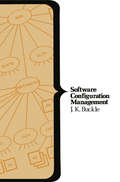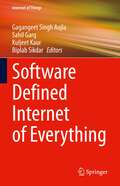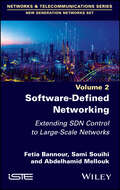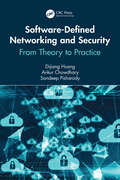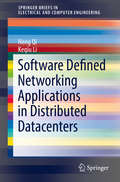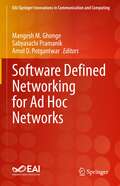- Table View
- List View
Software Composition: 7th International Symposium, SC 2008, Budapest, Hungary, March 29-30, 2008. Proceedings (Lecture Notes in Computer Science #4954)
by Cesare Pautasso Éric TanterThe goal of the International Symposia on Software Composition is to advance the state of the research in component-based software development. We focus on the challenges related to component development, reuse, veri?cation and, of course,composition.Softwarecompositionisbecomingmoreandmoreimportant as innovation in software engineering shifts from the development of individual components to their reuse and recombination in novel ways. To this end, for the 2008 edition, researchers were solicited to contribute on topics related to component adaptation techniques, composition languages, calculi and type systems, as well as emerging composition techniques such as aspect-oriented programming, service-oriented architectures, and mashups. In line with previous editions of SC, contributions were sought focusing on both theory and practice, with a particular interest in e?orts relating them. This LNCS volume contains the proceedings of the 7th International S- posium on Software Composition, which was held on March 29–30, 2008, as a satellite event of the European Joint Conferences on Theory and Practice of Software (ETAPS), in Budapest, Hungary. We received 90 initial submissions from all over the world, out of which 70 were considered for evaluation by a Program Committee consisting of 30 - ternational experts. Among these submissions, we selected 13 long papers and 6 short papers to be included in the proceedings and presented at the conf- ence. Each paper went through a thoroughrevisionprocess and was reviewedby three to ?ve reviewers. This ensured the necessary quality for publishing these proceedings in time for the event, a ?rst in the history of the symposium.
Software Configuration Management
by Jessica KeyesAn effective systems development and design process is far easier to explain than it is to implement. A framework is needed that organizes the life cycle activities that form the process. This framework is Configuration Management (CM). Software Configuration Management discusses the framework from a standards viewpoint, using the original
Software Configuration Management
by Jessica KeyesAn effective systems development and design process is far easier to explain than it is to implement. A framework is needed that organizes the life cycle activities that form the process. This framework is Configuration Management (CM). Software Configuration Management discusses the framework from a standards viewpoint, using the original
Software Configuration Management: ICSE Workshops SCM 2001 and SCM 2003, Toronto, Canada, May 14-15, 2001, and Portland, OR, USA, May 9-10, 2003. Selected Papers (Lecture Notes in Computer Science #2649)
by Bernhard Westfechtel André Van Der HoekSoftware Configuration Management Using Vesta (Monographs in Computer Science)
by Clark Allan Heydon Roy Levin Timothy P. Mann Yuan YuHelps in the development of large software projects. Uses a well-known open-source software prototype system (Vesta developed at Digital and Compaq Systems Research Lab).
Software Cost Estimation, Benchmarking, and Risk Assessment: The Software Decision-Makers' Guide to Predictable Software Development (The Fraunhofer IESE Series on Software and Systems Engineering)
by Adam TrendowiczSoftware effort estimation is a key element of software project planning and management. Yet, in industrial practice, the important role of effort estimation is often underestimated and/or misunderstood.In this book, Adam Trendowicz presents the CoBRA method (an abbreviation for Cost Estimation, Benchmarking, and Risk Assessment) for estimating the effort required to successfully complete a software development project, which uniquely combines human judgment and measurement data in order to systematically create a custom-specific effort estimation model. CoBRA goes far beyond simply predicting the development effort; it supports project decision-makers in negotiating the project scope, managing project risks, benchmarking productivity, and directing improvement activities. To illustrate the method’s practical use, the book reports several real-world cases where CoBRA was applied in various industrial contexts. These cases represent different estimation contexts in terms of software project environment, estimation objectives, and estimation constraints.This book is the result of a successful collaboration between the process management division of Fraunhofer IESE and many software companies in the field of software engineering technology transfer. It mainly addresses software practitioners who deal with planning and managing software development projects as part of their daily work, and is also of interest for students or courses specializing in software engineering or software project management.
Software Data Engineering for Network eLearning Environments: Analytics and Awareness Learning Services (Lecture Notes on Data Engineering and Communications Technologies #11)
by Santi Caballé Jordi ConesaThis book presents original research on analytics and context awareness with regard to providing sophisticated learning services for all stakeholders in the eLearning context. It offers essential information on the definition, modeling, development and deployment of services for these stakeholders. Data analysis has long-since been a cornerstone of eLearning, supplying learners, teachers, researchers, managers and policymakers with valuable information on learning activities and design. With the rapid development of Internet technologies and sophisticated online learning environments, increasing volumes and varieties of data are being generated, and data analysis has moved on to more complex analysis techniques, such as educational data mining and learning analytics. Now powered by cloud technologies, online learning environments are capable of gathering and storing massive amounts of data in various formats, of tracking user-system and user-user interactions, and of delivering rich contextual information.
Software Defect and Operational Profile Modeling (International Series in Software Engineering #4)
by Kai-Yuan Caialso in: THE KLUWER INTERNATIONAL SERIES ON ASIAN STUDIES IN COMPUTER AND INFORMATION SCIENCE, Volume 1
Software Defined Chips: Volume II
by Leibo Liu Shaojun Wei Jianfeng Zhu Chenchen DengThis book is the second volume of a two-volume book set which introduces software-defined chips. In this book, the programming model of the software-defined chips is analyzed by tracing the coevolution of modern general-purpose processors and programming models. The enhancement in hardware security and reliability of the software-defined chips are described from the perspective of dynamic and partial reconfiguration. The challenges and prospective trends of software-defined chips are also discussed. Current applications in the fields of artificial intelligence, cryptography, 5G communications, etc., are presented in detail. Potential applications in the future, including post-quantum cryptography, evolutionary computing, etc., are also discussed. This book is suitable for scientists and researchers in the areas of electrical and electronic engineering and computer science. Postgraduate students, practitioners and professionals in related areas are also potentially interested in the topic of this book.
Software Defined Chips: Volume I
by Shaojun Wei Leibo Liu Jianfeng Zhu Chenchen DengThis is the first book of a two-volume book set which introduces software defined chips. In this book, it introduces the conceptual evolution of software defined chips from the development of integrated circuits and computing architectures. Technical principles, characteristics and key issues of software defined chips are systematically analyzed. The hardware architecture design methods are described involving architecture design primitives, hardware design spaces and agile design methods. From the perspective of the compilation system, the complete process from high-level language to configuration contexts is introduced in detail. This book is suitable for scientists and researchers in the areas of electrical and electronic engineering and computer science. Postgraduate students, practitioners and professionals in related areas are also potentially interested in the topic of this book.
Software-Defined Cloud Centers: Operational and Management Technologies and Tools (Computer Communications and Networks)
by Pethuru Raj Anupama RamanThis practical text/reference provides an exhaustive guide to setting up and sustaining software-defined data centers (SDDCs). Each of the core elements and underlying technologies are explained in detail, often supported by real-world examples. The text illustrates how cloud integration, brokerage, and orchestration can ensure optimal performance and usage of data resources, and what steps are required to secure each component in a SDDC. The coverage also includes material on hybrid cloud concepts, cloud-based data analytics, cloud configuration, enterprise DevOps and code deployment tools, and cloud software engineering.Topics and features: highlights how technologies relating to cloud computing, IoT, blockchain, and AI are revolutionizing business transactions, operations, and analytics; introduces the concept of Cloud 2.0, in which software-defined computing, storage, and networking are applied to produce next-generation cloud centers; examines software-defined storage for storage virtualization, covering issues of cloud storage, storage tiering, and deduplication; discusses software-defined networking for network virtualization, focusing on techniques for network optimization in data centers; reviews the qualities and benefits of hybrid clouds, that bridge private and public cloud environments; investigates the security management of a software-defined data center, and proposes a framework for managing hybrid IT infrastructure components; describes the management of multi-cloud environments through automated tools, and cloud brokers that aim to simplify cloud access, use and composition; covers cloud orchestration for automating application integration, testing, infrastructure provisioning, software deployment, configuration, and delivery.This comprehensive work is an essential reference for all practitioners involved with software-defined data center technologies, hybrid clouds, cloud service management, cloud-based analytics, and cloud-based software engineering.
Software-Defined Data Infrastructure Essentials: Cloud, Converged, and Virtual Fundamental Server Storage I/O Tradecraft
by Greg SchulzSoftware-Defined Data Infrastructures Essentials provides fundamental coverage of physical, cloud, converged, and virtual server storage I/O networking technologies, trends, tools, techniques, and tradecraft skills. From webscale, software-defined, containers, database, key-value store, cloud, and enterprise to small or medium-size business, the book is filled with techniques, and tips to help develop or refine your server storage I/O hardware, software, and services skills. Whether you are new to data infrastructures or a seasoned pro, you will find this comprehensive reference indispensable for gaining as well as expanding experience with technologies, tools, techniques, and trends. We had a front row seat watching Greg present live in our education workshop seminar sessions for ITC professionals in the Netherlands material that is in this book. We recommend this amazing book to expand your converged and data infrastructure knowledge from beginners to industry veterans. —Gert and Frank Brouwer, Brouwer Storage Consultancy Software-Defined Data Infrastructures Essentials provides the foundational building blocks to improve your craft in serval areas including applications, clouds, legacy, and more. IT professionals, as well as sales professionals and support personnel, stand to gain a great deal by reading this book.—Mark McSherry, Oracle Regional Sales Manager Looking to expand your data infrastructure IQ? From CIOS to operations, sales to engineering, this book is a comprehensive reference, a must read for IT infrastructure professionals, beginners to seasoned experts.—Tom Becchetti, Advisory Systems Engineer Greg Schulz has provided a complete ‘toolkit’ for storage management along with the background and framework for the storage or data infrastructure professional or those aspiring to become one.—Greg Brunton, Experienced Storage and Data Management Professional
Software-Defined Data Infrastructure Essentials: Cloud, Converged, and Virtual Fundamental Server Storage I/O Tradecraft
by Greg SchulzSoftware-Defined Data Infrastructures Essentials provides fundamental coverage of physical, cloud, converged, and virtual server storage I/O networking technologies, trends, tools, techniques, and tradecraft skills. From webscale, software-defined, containers, database, key-value store, cloud, and enterprise to small or medium-size business, the book is filled with techniques, and tips to help develop or refine your server storage I/O hardware, software, and services skills. Whether you are new to data infrastructures or a seasoned pro, you will find this comprehensive reference indispensable for gaining as well as expanding experience with technologies, tools, techniques, and trends. We had a front row seat watching Greg present live in our education workshop seminar sessions for ITC professionals in the Netherlands material that is in this book. We recommend this amazing book to expand your converged and data infrastructure knowledge from beginners to industry veterans. —Gert and Frank Brouwer, Brouwer Storage Consultancy Software-Defined Data Infrastructures Essentials provides the foundational building blocks to improve your craft in serval areas including applications, clouds, legacy, and more. IT professionals, as well as sales professionals and support personnel, stand to gain a great deal by reading this book.—Mark McSherry, Oracle Regional Sales Manager Looking to expand your data infrastructure IQ? From CIOS to operations, sales to engineering, this book is a comprehensive reference, a must read for IT infrastructure professionals, beginners to seasoned experts.—Tom Becchetti, Advisory Systems Engineer Greg Schulz has provided a complete ‘toolkit’ for storage management along with the background and framework for the storage or data infrastructure professional or those aspiring to become one.—Greg Brunton, Experienced Storage and Data Management Professional
A Software-Defined GPS and Galileo Receiver: A Single-Frequency Approach (Applied and Numerical Harmonic Analysis)
by Kai Borre Dennis M. Akos Nicolaj Bertelsen Peter Rinder Søren Holdt JensenThis book explore the use of new technologies in the area of satellite navigation receivers. In order to construct a reconfigurable receiver with a wide range of applications, the authors discuss receiver architecture based on software-defined radio techniques. The presentation unfolds in a user-friendly style and goes from the basics to cutting-edge research. The book is aimed at applied mathematicians, electrical engineers, geodesists, and graduate students. It may be used as a textbook in various GPS technology and signal processing courses, or as a self-study reference for anyone working with satellite navigation receivers.
Software Defined Internet of Everything (Internet of Things)
by Gagangeet Singh Aujla Sahil Garg Kuljeet Kaur Biplab SikdarThis book provides comprehensive discussion on key topics related to the usage and deployment of software defined networks (SDN) in Internet of Everything applications like, healthcare systems, data centers, edge/fog computing, vehicular networks, intelligent transportation systems, smart grids, smart cities and more. The authors provide diverse solutions to overcome challenges of conventional network binding in various Internet of Everything applications where there is need of an adaptive, agile, and flexible network backbone. The book showcases different deployment models, algorithms and implementations related to the usage of SDN in Internet of Everything applications along with the pros and cons of the same. Even more, this book provides deep insights into the architecture of software defined networking specifically about the layered architecture and different network planes, logical interfaces, and programmable operations. The need of network virtualization and the deployment models for network function virtualization is also included with an aim towards the design of interoperable network architectures by researchers in future. Uniquely, the authors find hands on practical implementation, deployment scenarios and use cases for various software defined networking architectures in Internet of Everything applications like healthcare networks, Internet of Things, intelligent transportation systems, smart grid, underwater acoustic networks and many more. In the end, design and research challenges, open issues, and future research directions are provided in this book for a wide range of readers
Software Defined Networking: Design and Deployment
by Patricia A. Morreale James M. AndersonSoftware Defined Networking: Design and Deployment provides a comprehensive treatment of software defined networking (SDN) suitable for new network managers and experienced network professionals. Presenting SDN in context with more familiar network services and challenges, this accessible text:Explains the importance of virtualization, particularly
Software Defined Networking: Design and Deployment
by Patricia A. Morreale James M. AndersonSoftware Defined Networking: Design and Deployment provides a comprehensive treatment of software defined networking (SDN) suitable for new network managers and experienced network professionals. Presenting SDN in context with more familiar network services and challenges, this accessible text:Explains the importance of virtualization, particularly
Software-Defined Networking 2: Extending SDN Control to Large-Scale Networks (pdf)
by Fetia Bannour Sami Souihi Abdelhamid MelloukSoftware-Defined Networking 2: Extending SDN Control to Large-Scale Networks
by Fetia Bannour Sami Souihi Abdelhamid MelloukSoftware-Defined Networking and Security: From Theory to Practice (Data-Enabled Engineering)
by Dijiang Huang Ankur Chowdhary Sandeep PisharodyThis book provides readers insights into cyber maneuvering or adaptive and intelligent cyber defense. It describes the required models and security supporting functions that enable the analysis of potential threats, detection of attacks, and implementation of countermeasures while expending attacker resources and preserving user experience. This book not only presents significant education-oriented content, but uses advanced content to reveal a blueprint for helping network security professionals design and implement a secure Software-Defined Infrastructure (SDI) for cloud networking environments. These solutions are a less intrusive alternative to security countermeasures taken at the host level and offer centralized control of the distributed network. The concepts, techniques, and strategies discussed in this book are ideal for students, educators, and security practitioners looking for a clear and concise text to avant-garde cyber security installations or simply to use as a reference. Hand-on labs and lecture slides are located at http://virtualnetworksecurity.thothlab.com/. Features Discusses virtual network security concepts Considers proactive security using moving target defense Reviews attack representation models based on attack graphs and attack trees Examines service function chaining in virtual networks with security considerations Recognizes machine learning and AI in network security
Software-Defined Networking and Security: From Theory to Practice (Data-Enabled Engineering)
by Dijiang Huang Ankur Chowdhary Sandeep PisharodyThis book provides readers insights into cyber maneuvering or adaptive and intelligent cyber defense. It describes the required models and security supporting functions that enable the analysis of potential threats, detection of attacks, and implementation of countermeasures while expending attacker resources and preserving user experience. This book not only presents significant education-oriented content, but uses advanced content to reveal a blueprint for helping network security professionals design and implement a secure Software-Defined Infrastructure (SDI) for cloud networking environments. These solutions are a less intrusive alternative to security countermeasures taken at the host level and offer centralized control of the distributed network. The concepts, techniques, and strategies discussed in this book are ideal for students, educators, and security practitioners looking for a clear and concise text to avant-garde cyber security installations or simply to use as a reference. Hand-on labs and lecture slides are located at http://virtualnetworksecurity.thothlab.com/. Features Discusses virtual network security concepts Considers proactive security using moving target defense Reviews attack representation models based on attack graphs and attack trees Examines service function chaining in virtual networks with security considerations Recognizes machine learning and AI in network security
Software Defined Networking Applications in Distributed Datacenters (SpringerBriefs in Electrical and Computer Engineering)
by Heng Qi Keqiu LiThis SpringerBrief provides essential insights on the SDN application designing and deployment in distributed datacenters. In this book, three key problems are discussed: SDN application designing, SDN deployment and SDN management.This book demonstrates how to design the SDN-based request allocation application in distributed datacenters. It also presents solutions for SDN controller placement to deploy SDN in distributed datacenters. Finally, an SDN management system is proposed to guarantee the performance of datacenter networks which are covered and controlled by many heterogeneous controllers.Researchers and practitioners alike will find this book a valuable resource for further study on Software Defined Networking.
Software Defined Networking for Ad Hoc Networks (EAI/Springer Innovations in Communication and Computing)
by Sabyasachi Pramanik Mangesh M. Ghonge Amol D. PotgantwarThis book offers a comprehensive overview of Software-Defined Network (SDN) based ad-hoc network technologies and exploits recent developments in this domain, with a focus on emerging technologies in SDN based ad-hoc networks. The authors offer practical and innovative applications in Network Security, Smart Cities, e-health, and Intelligent Systems. This book also addresses several key issues in SDN energy-efficient systems, the Internet of Things, Big Data, Cloud Computing and Virtualization, Machine Learning, Deep Learning, and Cryptography. The book includes different ad hoc networks such as MANETs and VANETs, along with a focus on evaluating and comparing existing SDN-related research on various parameters. The book provides students, researchers, and practicing engineers with an expert guide to the fundamental concepts, challenges, architecture, applications, and state-of-the-art developments in the field.
Software-Defined Networking for Future Internet Technology: Concepts and Applications
by Kshira Sagar SahooNetwork infrastructures are growing rapidly to meet the needs of business, but the required repolicing and reconfiguration provide challenges that need to be addressed. The software-defined network (SDN) is the future generation of Internet technology that can help meet these challenges of network management. This book includes quantitative research, case studies, conceptual papers, model papers, review papers, and theoretical backing on SDN. This book investigates areas where SDN can help other emerging technologies deliver more efficient services, such as IoT, industrial IoT, NFV, big data, blockchain, cloud computing, and edge computing. The book demonstrates the many benefits of SDNs, such as reduced costs, ease of deployment and management, better scalability, availability, flexibility and fine-grained control of traffic, and security. The book demonstrates the many benefits of SDN, such as reduced costs, ease of deployment and management, better scalability, availability, flexibility and fine-grained control of traffic, and security. Chapters in the volume address: Design considerations for security issues and detection methods State-of-the-art approaches for mitigating DDos attacks using SDN Big data using Apache Hadoop for processing and analyzing large amounts of data Different tools used for attack simulation Network policies and policy management approaches that are widely used in the context of SDN Dynamic flow tables, or static flow table management A new four-tiered architecture that includes cloud, SDN-controller, and fog computing Architecture for keeping computing resources available near the industrial IoT network through edge computing The impact of SDN as an innovative approach for smart city development More. The book will be a valuable resource for SDN researchers as well as academicians, research scholars, and students in the related areas.

